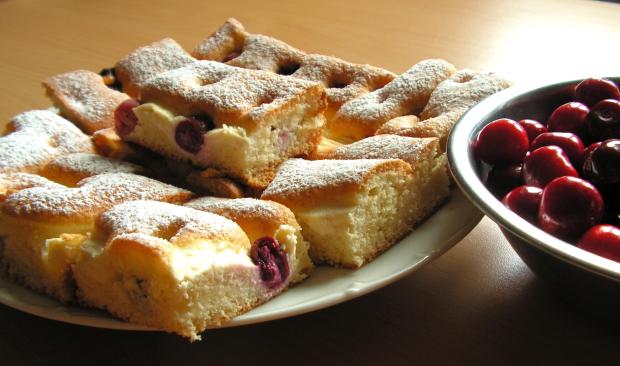
Rather large rounded cakes with various sweet fillings come from south-western part of the Czech Republic, that was always surrounded by Germany. Patriotic people of this region, called Chodové, used to work as guards protecting the border from potential invaders. Chodové maintained their culture and traditions from german influences. There are references in the literature from 19th century about processions of Chodové to nearby hill with church of St. Vicent. Procession were accompanied with celebrations and festivities. People used to dress up in their best traditional clothes and prepared large circle sweet cakes. Legends say that women used to wake up 3 times during the night to knead the growing dough for cakes. Fillings were prepared from poppy seeds, dark plum marmalade, ground and boiled nuts or ricotta (tvaroh). White creamy ricotta had to be located always in the centre of the round cake and the rest of the decorative ingredients reflected from which village the cake comes from. The ornament of the cake resembled the landscape of frontier countryside where plum marmalade or poppy seed filling represent pasture lands and forests, raisins and almonds then resembled houses.
2 dl milk
80 g caster sugar
3 yolks
25 g fresh yeast
120 g butter
pitch of salt
flour for rolling dough
1 beaten egg to brush surface of cake at the end
raisins, almonds and walnuts for decoration
filling from poppy seeds, ricotta and plum marmalade
Poppy seed filling
Grind about 200 g of poppy seeds in a mill or coffee grinder or just directly buy them finely ground. Combine oily poppy seeds with 250 ml of milk, 2 tablespoons of dark rum, 2 table spoons of honey and 60 g of vanilla sugar. 4 ground cloves could be added too. The mixture is then slowly cooked on low heat, being constantly stirred, until the sugar dissolves. Continue to cook and stir until the mixture begins to thicken. Remove from heat and cool before use.
Ricottafilling (tvarohová náplň)
In a bowl simply mix well 0.5 kg of ricotta (czech tvaroh) with one yolk, 80 g of icing sugar, 2 tablespoons of dark rum and mix well until sugar gets dissolved. Then add gently meringue from one egg white and use directly for decorating of store some hours in cold.
Plum filling
For the best result use dark thick marmalade, in Czech republic called “povidla” and add for 400 g of povidla 4 tablespoons of dark rum and a bit of cinnamon.
Cake dough
Combine yeast, 1 spoon of sugar and 3 spoons of flour with warm but not hot milk and the surface with more flour. Let the yeast grow until the volume at least doubles. Meanwhile in a big bowl mix the rest of flour and sugar, pitch of salt, yolks and warm butter. Add the yeasts and knead well to have smooth and slightly sticky dough. Form a ball from it, sprinkle it with flour and the bowl cover with clear dish towel. Keep the dough in a warm place to let it grow more or less 2 hours. Then move the dough onto well floured work surface, divide it into several parts and from each of them roll smaller or bigger circle. Move the circles of future cakes into baking tray covered with baking paper. Using your fingers gently push and move the dough in a direction out from each circle towards its borders, so except the thick edges the dough is thin. Then finally decorate the cakes with the filling according to your taste and imagination. Don‘t forget to use raisins or almonds that can’t miss on authentic “chodský koláč”. Brush the edges with beaten egg to give them nice gloss and put the tray into pre-heated oven on 200oC. Bake about 15-20 minutes until the edges of cakes turn golden-brown.









